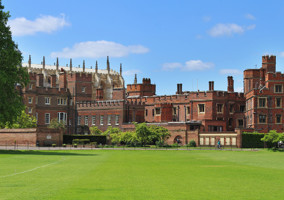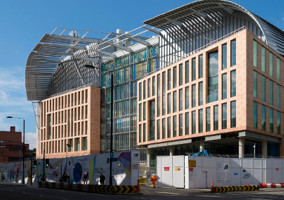The top-performing charity in this month’s review of the haysmacintyre / Charity Finance 100 Index is the Archbishops’ Council, which reports a 64 per cent increase in income to £138.4m in the financial year ending 31 December 2017. The council exists to further the work and mission of the Church of England, providing support to churches in dioceses and locally.
Its income rise came about largely thanks to grant income from the Church Commissioners for England, which manages the Church’s investment fund. The Commissioners more than doubled their support to £92.6m between 2016 and 2017 as part of the Reform and Renewal Programme adopted by the Church in 2015. This money will not all be distributed immediately as some of it represents commitments for future years.
According to secretary general William Nye, the Archbishops’ Council “now makes much more deliberate use of the resources provided to it by the Church Commissioners, with large grants available on application from dioceses for projects for evangelism and church growth, and significant sums made available to dioceses for ministry in lowest income communities.”
In order to enable the dioceses to adapt to these changes, the Church Commissioners have made additional time-limited funding available.
Islamic Relief Worldwide also performed well in 2017, reporting a 15 per cent increase in income to £126.5m. This was aided by a 24 per cent increase in voluntary income to £107.1m, which more than offset an 18 per cent fall in institutional funding.
Over 70 per cent of the charity’s voluntary income derives from 17 Islamic Relief partner offices, which are registered as charities in their own right. They donated £77.8m in 2017, up 29 per cent from £60.4m in 2016.
Elsewhere, the Leverhulme Trust reported total income of £99.4m in 2017, up 15 per cent from £86.7m in 2016. Investment income accounts for all of the Trust’s income, and over 80 per cent of this derives from dividends in the consumer goods company Unilever.
At the same time, the value of the Trust’s funds at the end of 2017 increased by £617m or 23 per cent to £3,256m. Over 90 per cent of the increase in value is attributable to the rise in market value of Unilever, which resulted in an unrealised gain of £570.9m.
The fourth charity filing an annual income gain of over 10 per cent in the fourth quarter of 2017 is the British Red Cross Society, which reported a 14 per cent increase in total income to £280.6m, excluding net gains on the disposal of tangible fixed assets of £3.9m in 2017.
The relief charity’s income streams are well diversified, with voluntary income accounting for 46 per cent of total income, followed by charitable activities at 32 per cent and legacy and trading income at 11 per cent each. Voluntary income grew by 23 per cent, while income from charitable activities grew by 13 per cent.
Heritage, culture and the arts
Charities with financial year ends falling in the first quarter of 2018 have started to file their accounts, and these are included in the table in the pdf. Among these early filers there is a strong prevalence of charities active in heritage, culture and the arts.
Across the Charity 100 and Charity 250 Indexes, there are 30 charities involved in this broad sector. They span from the National Trust with annual income of £593.6m to the Wales Millennium Centre with annual income of £21.7m.
In between are a diverse range of sub-sectors including the performing arts (mainly theatre, opera and ballet), museums and art galleries, and heritage properties and sites of historic interest such as Historic Royal Palaces.
Taking all charities active in heritage, culture and the arts in the Charity 100 and Charity 250 Indexes as a composite, income from charitable activities accounts for 73 per cent of income, followed by trading income at 15 per cent, voluntary income at 8 per cent and the remaining 4 per cent split evenly between legacy and investment income.
Income from charitable activities includes fees for services, though it also includes a significant amount of state funding in the form of grant in aid and Heritage Lottery funding in the museums and art galleries sub-sector, and Arts Council funding in the performing arts sub-sector.
Against a backdrop of central and local government funding pressures, a series of creative tax reliefs introduced by HMRC over the last few years are providing a lifeline. They include theatre tax relief, available since September 2014; orchestra tax relief, available since April 2016; and museums and galleries tax relief, available since April 2017.
Whilst it is still early days for the latter two, theatre tax relief is beginning to make an impact. A case in point is the Royal National Theatre, which is using creative tax reliefs to offset cuts in Arts Council funding.
The Royal National Theatre received Arts Council funding of £17.2m in 2017/18. However, its four-year funding settlement running up to 2021/22 has been cut to £16.7m per annum, representing a 3 per cent reduction.
According to the trustees, the “Arts Council grant has been cut by £2.9m since 2010-11, representing a real terms reduction of 30 per cent.” As a result, the Royal National Theatre has become “increasingly dependent in recent years on theatre and film tax credits, which in 2017/18 amounted to £4.6m”.
According to HMRC figures, there were 910 successful claims for theatre tax relief in 2017/18 amounting to £77m, up 67 per cent from the £46m paid out in 2016. A total of £137m has been awarded to almost 5,000 theatre productions since the scheme began.
Meanwhile, £6.6m has been paid out in orchestra tax relief on 205 productions since 2016. There are no statistics available yet on claims for museums and galleries tax relief.
“Creative sector tax reliefs are a welcome source of support for charities active in the heritage, arts and culture sector, but charities do need to be aware of the practicalities involved in applying for them and the time lag between putting in a claim and receiving the money,” says haysmacintyre’s head of charities and not-for-profit Richard Weaver.
Another arguably less welcome tax issue highlighted by Weaver is the current government consultation over whether the off-payroll working rules known as IR35 should be extended into the private sector. At present the rules only apply in the public sector, but their extension would see charities fall under the remit.
“There are a lot of self-employed people working in the arts sector and the extension of IR35 would lead to increased scrutiny over whether they are genuinely self-employed or whether they are effectively employees, with attendant consequences for their employment rights and their tax and national insurance status,” he says.
Related Articles











